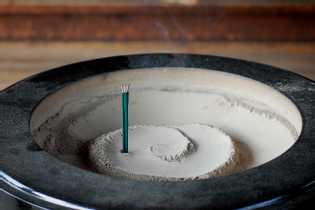線香( せんこう) - Senko (incense sticks)
Incense sticks called senko and candles are burned and offered on butsudans (household Buddhist altars) and at tombs when Buddhists pray for the departed souls of their ancestors. Incense sticks are placed standing up in the ashes of the incense burners and burned as offerings to the spirits of the departed. The main ingredients in the incense sticks are fragrant woods such as sandalwood, agalloch, benzoin, and clove and animal perfumes such as musk and castor. A blend of some of these perfumes is first kneaded with a green or brown colorant and pine resin. Then it hardens into sticks. Another type of incense sticks widely used is made from a mixture of powdered cryptomeria needles and perfumes.
線香は香料を棒状に固めたもので、灯明とともに仏教徒が先祖の霊を供養するときに仏壇や墓前に供えます。香炉の灰に線香を立て、火を点けてくゆらし、仏前に供えます。線香の主成分は、白檀(びゃくだん)・沈香(じんこう)・伽羅(きゃら)・安息香・丁子(ちょうじ)などの香木や麝香(じゃこう)・海狸香(かいりこう)などの動物性の香料です。これらの香料を混ぜ合わせたものに緑または茶の着色剤と松脂を加えて棒状に練り固めて作ります。この他に、粉末にした杉の葉に香料を混ぜて作った線香も広く使われています。
Incense sticks were introduced to Japan from China early in the Edo period (1603 to 1867) and took the place of the incense powder that had been widely used because the incense sticks were much easier to handle. Since then incense sticks have been indispensable articles for all Buddhist ceremonies and services including funerals and memorial services for the deceased. Incense sticks are also burned and offered at tombs when people visit graves.
線香は江戸時代の初期に中国から日本に伝えられました。それ以前は、粉状の香が広く使われていましたが、取り扱いがはるかに簡単な線香がこれに取って代わり、葬式や法事などの仏教の儀式や墓参りにはなくてはならないものとなっています。
